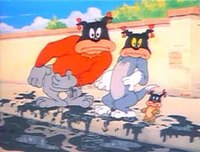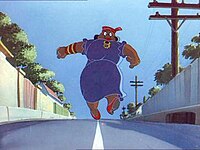History[edit]
"Tom and Jerry" was a commonplace phrase for youngsters indulging in riotous behaviour in 19th-century London. The term comes from
Life in London, or Days and Nights of Jerry Hawthorne and his elegant friend Corinthian Tom (1823) by
Pierce Egan.
[8] However
Brewer notes no more than an "unconscious" echo of the
Regency era original in the naming of the cartoon.
[9]
Hanna-Barbera era (1940–58)[edit]
William Hanna and
Joseph Barbera were both part of the
Rudolf Ising unit at the
MGM cartoon studio in the late 1930s. After the financial disaster of a series of MGM cartoons based upon the
Captain and the Kids comic strip characters, Barbera, a storyman and character designer, was paired (out of desperation) with Hanna, an experienced director, to start directing films for the Ising unit. In their first discussion for a cartoon, Barbera suggested a cat-and-mouse cartoon titled
Puss Gets the Boot. "We knew we needed two characters. We thought we needed conflict, and chase and action. And a cat after a mouse seemed like a good, basic thought," as he recalled in an interview.
[10] Hanna and other employees complained that the idea wasn't very original; nevertheless, the short was completed in late 1939, and released to theaters on February 10, 1940.
Puss Gets The Boot centers on Jasper, a gray tabby cat trying to catch a mouse named Jinx (whose name is not mentioned within the cartoon itself), but after accidentally breaking a houseplant and its stand, the African American housemaid Mammy has threatened to throw Jasper out if he breaks one more thing in the house. Naturally, Jinx uses this to his advantage, and begins tossing any and everything fragile, so that Jasper will be thrown outside.
Puss Gets The Boot was previewed and released without fanfare, and Hanna and Barbera went on to direct other non-cat-and-mouse related shorts such as
Gallopin' Gals (1940) and
Officer Pooch (1941). "After all," remarked many of the MGM staffers, "haven't there been enough cat-and-mouse cartoons already?"
The pessimistic attitude towards the cat and mouse duo changed when the cartoon became a favorite with theater owners and with the
Academy of Motion Picture Arts and Sciences, which nominated the film for the
Academy Award for Best Short Subject: Cartoons of 1941. It lost to another MGM cartoon, Rudolph Ising's
The Milky Way.
Producer
Fred Quimby, who ran the MGM animation studio, quickly pulled Hanna and Barbera off the other one-shot cartoons they were working on, and commissioned a series featuring the cat and mouse. Hanna and Barbera held an intra-studio contest to give the pair a new name by drawing suggested names out of a hat; animator John Carr won $50 with his suggestion of
Tom and Jerry, at the time best known as the name of
a Christmastime mixed drink.
[11] The
Tom and Jerry series went into production with
The Midnight Snackin 1941, and Hanna and Barbera rarely directed anything but the cat-and-mouse cartoons for the rest of their tenure at MGM. Barbera would create the story for each short while Hanna would supervise production.
Tom's physical appearance evolved significantly over the years. During the early 1940s, Tom had an excess of detail—shaggy fur, numerous facial
wrinkles, and multiple eyebrow markings, all of which were streamlined into a more workable form by the end of the 1940s. In addition, he also looked like a more realistic cat early on; evolving from his quadrupedal beginnings Tom to become increasingly and almost exclusively bipedal. By contrast, Jerry's design remained essentially the same for the duration of the series. By the mid-1940s, the series had developed a quicker, more energetic and violent tone, due to the inspiration from the work of their colleague in the MGM cartoon studio,
Tex Avery, who joined the studio in 1942.
Even though the theme of each short is virtually the same – cat chases mouse – Hanna and Barbera found endless variations on that theme. Barbera's storyboards and rough layouts and designs, combined with Hanna's timing, resulted in MGM's most popular and successful cartoon series. Thirteen entries in the
Tom and Jerry series (including
Puss Gets The Boot) were nominated for the Academy Award for Best Short Subject: Cartoons; seven of them went on to win the Academy Award, breaking the
Disney studio's winning streak in that category.
Tom and Jerry won more Academy Awards than any other character-based theatrical animated series.
Tom and Jerry remained popular throughout their original theatrical run, even when the budgets began to tighten in the 1950s and the pace of the shorts slowed slightly. However, after
television became popular in the 1950s,
box office revenues decreased for theatrical films, and short subjects. At first, MGM combated this by going to all-CinemaScope production on the series. After MGM realized that their re-releases of the older cartoons brought in just as much money as the new cartoons did, the studio executives decided, much to the surprise of the staff, to close the animation studio. The MGM cartoon studio was shut down on May 15, 1957, and the last of the 114 Hanna-Barbera
Tom and Jerry shorts,
Tot Watchers, was released on August 1, 1958. Hanna and Barbera established their own television animation studio,
Hanna-Barbera Productions, on July 7, 1957, which went on to produce hit TV shows, such as
The Flintstones,
Yogi Bear,
The Jetsons and
Scooby-Doo.



